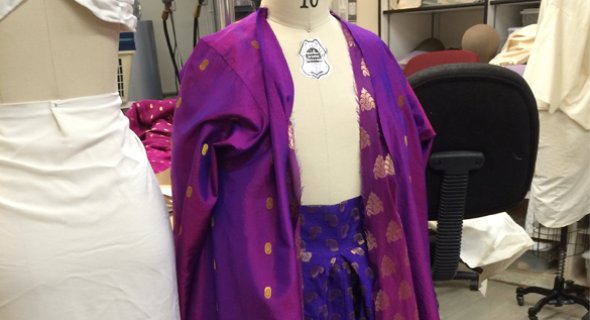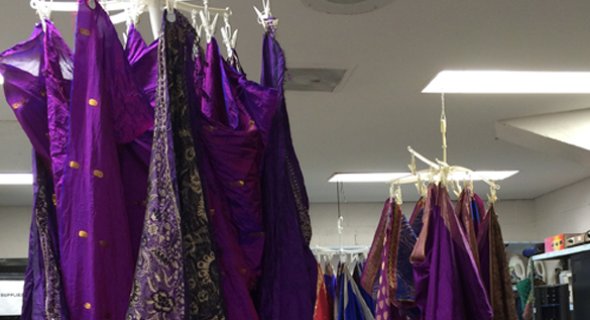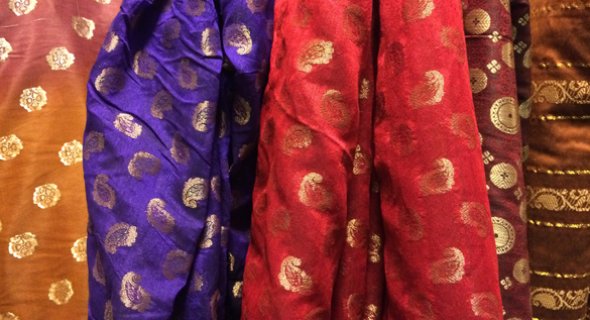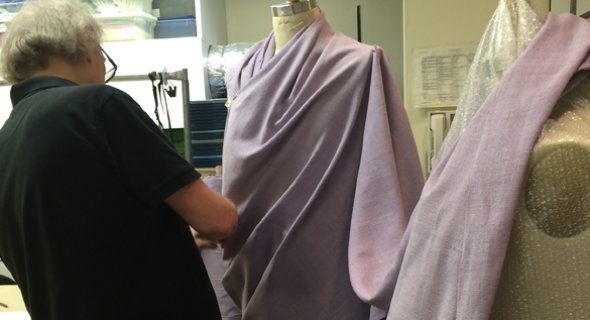Had not Rodgers and Hammerstein called their musical The King and I, they could have titled it Silk. Such is my thought each time I prowl the hallways backstage at the Vivian Beaumont and look at the racks of costumes, while observing the production’s wardrobe wizards, or dressers, working on this clothing. So vast is the number of costumes – there is a cast of 51, many in multiple looks: no one has an exact total for the outfits – that small work tables have arisen outside the dressing rooms. At them, dressers can be seen throughout the afternoon and evening, fixing a button, adjusting a headpiece, smoothing out a wrinkle. If, as Proverbs has it, “Idle hands are the devil’s workshop,” then the dressers and costume technicians are veritable angels.
Angels, in fact, is the name of the London-based supply company that provided some of the costumes. Many, however, were made in-house. I gleaned this fact the other afternoon when I wandered to the end of a backstage hallway and pierced the dressers’ and technicians’ inner sanctum. In this large room, four highly skilled people were focused on the painstaking work of adjusting or mending costumes. They were gracious enough to look up from their activity long enough to indulge my questions.
One of this group, James (Jim) Nadeaux, has worked on such previous LCT shows as War Horse. “I’ve done everything in theater,” he joked, “but sweep the stage, and I haven’t done that only because Local One won’t let me.” Nadeaux dresses Ken Watanabe, who plays the King. Nadeaux told me that a certain rich hue the King wears is unique to that character and his station: “It’s a brownish-red, and very beautiful.”
Once the cast got on the Beaumont stage, a situation arose regarding the King that required royal dispatch. “He needed a quick change, so we had to make an entirely new costume for him,” Nadeaux said. “We did it in 6 hours.” Speed is essential when costumes can need adjustments almost daily. “One of the reasons we have this on-site workshop,” Nadeaux said, “is that sending costumes out for a repair and waiting for them to come back would take too long.”
The workshop has constructed costumes for more than merely the King. Sam Brooks, who has been working in the on-site atelier since December, told me that all of the kids’ costumes for “The March of Siamese Children” were made in-house. “Jim and I also worked on the monks’ costumes. Each one of them contains 8 yards of 54-inch-wide changeable silk.” There are 10 monks, so when you factor in adjustments enough silk has been used just for that ensemble to stretch the length of a football field.
Talking to these skilled costume technicians for even a few minutes offers a short course in not only quantity of silk but also its types. There is Brocade and Charmeuse and Georgette and Shantung – it feels as if you’ve just been introduced to a clowder of Siamese cats. Asked which of these fabrics is the toughest to repair, Brooks responded: “Sari silks can be challenging because they are very thin.”
I asked Libby Villanova, a third member of the workshop team, which character’s costumes she preferred. As hesitant as a parent asked to name a favorite child, Villanova nonetheless replied, “I really like Lady Thiang’s things. It was very difficult to get the right angle on all of her skirts. She looks so amazing – I am really proud of the work we did there.”
Another atelier adept, Elise VanderKley, gave me a metaphorical way in to understand the demands of working with silk. “It’s almost as if you can have a conversation while you’re working with these fabrics. Each time you touch them it’s as if they are saying something to you – they tell you what they need.” This tactile relationship between human and silk, VanderKley said, is a main reason why those who work with delicate textiles may be the only people alive who will never be replaced by robots.
I had to agree: there may come a day when robots play Anna Leonowens and the King of Siam, but their exquisite fashions will forever be made and maintained by those as skilled as Nadeaux and Brooks and Villanova and VanderKley.
Brendan Lemon is the American theater critic for the Financial Times and the editor of lemonwade.com.




